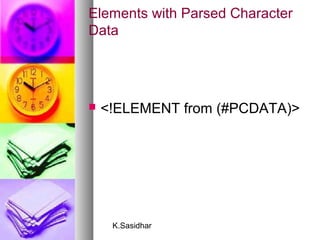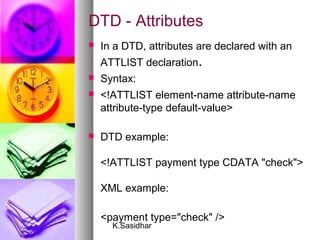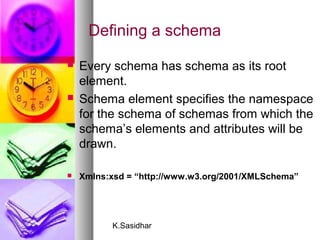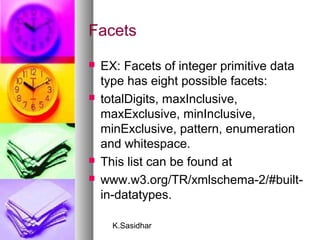Xml sasidhar
- 1. K.Sasidhar What is XML?What is XML? XML stands for EXtensible Markup Language XML is a markup language much like HTML XML was designed to carry data, not to display data XML tags are not predefined. You must define your own tags XML is designed to be self-descriptive XML is a W3C Recommendation
- 2. K.Sasidhar The Difference Between XML andThe Difference Between XML and HTMLHTML XML is not a replacement for HTML. XML and HTML were designed with different goals: XML was designed to transport and store data, with focus on what data is HTML was designed to display data, with focus on how data looks HTML is about displaying information, while XML is about carrying information. XML was created to structure, store, and transport information. XML language has no predefined tags
- 3. K.Sasidhar Differences continue….Differences continue…. XML is used to transport data, while HTML is used to format and display the data. XML is a software- and hardware- independent tool for carrying information. With XML You Invent Your Own Tags XML is a W3C Recommendation
- 4. K.Sasidhar Facts of XMLFacts of XML XML Separates Data from HTMLXML Separates Data from HTML If you need to display dynamic data in yourIf you need to display dynamic data in your HTML document, it will take a lot of work toHTML document, it will take a lot of work to edit the HTML each time the data changes.edit the HTML each time the data changes. With XML, data can be stored in separateWith XML, data can be stored in separate XML files. This way you can concentrate onXML files. This way you can concentrate on using HTML/CSS for display and layout,using HTML/CSS for display and layout, and be sure that changes in the underlyingand be sure that changes in the underlying data will not require any changes to thedata will not require any changes to the HTML.HTML. With a few lines of JavaScript code, youWith a few lines of JavaScript code, you can read an external XML file and updatecan read an external XML file and update the data content of your web page.the data content of your web page.
- 5. K.Sasidhar Facts of XMLFacts of XML XML Simplifies Data Sharing XML data is stored in plain text format. This provides a software- and hardware- independent way of storing data. This makes it much easier to create data that can be shared by different applications. XML Simplifies Data Transport One of the most time-consuming challenges for developers is to exchange data between incompatible systems over the Internet.
- 6. K.Sasidhar FACTS OF XMLFACTS OF XML XML Simplifies Platform ChangesXML Simplifies Platform Changes XML Makes Your Data MoreXML Makes Your Data More AvailableAvailable XML is a meta mark up languageXML is a meta mark up language that specifies rules for creatingthat specifies rules for creating markup languagesmarkup languages
- 7. K.Sasidhar XML DOCUMENT CONTENTXML DOCUMENT CONTENT XML Document composed of 1. Declarations (dtd reference) 2. Elements 3. Comments 4. Entities (Pre-defined, Custom – defined, character)
- 9. K.Sasidhar XML SYNTAXXML SYNTAX Syntax is two levels.Syntax is two levels. Low level syntax that imposeLow level syntax that impose rules on all xml documents.rules on all xml documents. Other level is either documentOther level is either document type definition (DTD) or XMLtype definition (DTD) or XML schemas.schemas.
- 10. K.Sasidhar XML Syntax Continues….XML Syntax Continues…. DTDs and schemas specify theDTDs and schemas specify the set of tags and attributes thatset of tags and attributes that can appear in a particularcan appear in a particular document or collection ofdocument or collection of documents.documents. Also specify the order andAlso specify the order and arrangement in which they canarrangement in which they can appear.appear.
- 11. K.Sasidhar XML StatementsXML Statements ElementsElements Markup declarations areMarkup declarations are instructions to the xml parser,instructions to the xml parser, and processing instructions.and processing instructions.
- 12. K.Sasidhar XML Program structureXML Program structure XML declarationXML declaration -- identifies the document as XML and provides the-- identifies the document as XML and provides the version number of XML.version number of XML. CommentsComments Same as HTMLSame as HTML XML namesXML names Names are used to name elements and attributes.Names are used to name elements and attributes. Names are case sensitiveNames are case sensitive
- 13. K.Sasidhar ElementsElements Root elementRoot element Xml document defines a single root element,Xml document defines a single root element, opening tag and must appear on the first line of theopening tag and must appear on the first line of the code.code. All other elements must be nested inside the rootAll other elements must be nested inside the root element.element.
- 14. K.Sasidhar EX. PROGRAMEX. PROGRAM <?xml version = “1.0” encoding= “utf-8”?><?xml version = “1.0” encoding= “utf-8”?> <ad><ad> <year> 2012</year><year> 2012</year> <make> Maruthi </make><make> Maruthi </make> <model> Alto Lxi </model><model> Alto Lxi </model> <color> blue</color><color> blue</color> <location><location> <city> hyderabad </city><city> hyderabad </city> <state> AP </state><state> AP </state> </location></location> </ad></ad>
- 15. K.Sasidhar Document Type Definitions DTD is a set of structural rules called declarations. DTD Specify the position of a set of elements. DTD Provides entity definitions also. DTDs are used when the same tag set definition is used by a collection of documents, perhaps by a collection of users, and the documents must have a consistent and uniform structure.
- 16. K.Sasidhar DTD DTD that embedded with XML is called internal DTD. DTD stored in a separate file is called external DTD. External DTD allows use with more than one XML document, and are preferable. DTD defines the document structure with a list of legal elements and attributes.
- 17. K.Sasidhar Internal DTD Example <?xml version="1.0"?> <!DOCTYPE note [ <!ELEMENT note (to,from,heading,body)> <!ELEMENT to (#PCDATA)> <!ELEMENT from (#PCDATA)> <!ELEMENT heading (#PCDATA)> <!ELEMENT body (#PCDATA)> ]> <note> <to>clerk</to> <from>HOD</from> <heading>Issue Hall Tickets</heading> <body>Issue the hall tickets for those who had required attendance</body> </note>
- 18. K.Sasidhar DTD ex: explanation The DTD above is interpreted like this: !DOCTYPE note defines that the root element of this document is note !ELEMENT note defines that the note element contains four elements: "to,from,heading,body" !ELEMENT to defines the to element to be of type "#PCDATA" !ELEMENT from defines the from element to be of type "#PCDATA" !ELEMENT heading defines the heading element to be of type "#PCDATA" !ELEMENT body defines the body element to be of type "#PCDATA"
- 19. K.Sasidhar External DTD declaration ex: <!ELEMENT note (to,from,heading,body)> <!ELEMENT to (#PCDATA)> <!ELEMENT from (#PCDATA)> <!ELEMENT heading (#PCDATA)> <!ELEMENT body (#PCDATA)>
- 20. K.Sasidhar DTD continue…. <?xml version="1.0"?> <!DOCTYPE note SYSTEM "note.dtd"> <note> <to>clerk</to> <from>HOD</from> <heading>Issue Hall Tickets </heading> <body> Issue the hall tickets for those who had required attendance </body> </note>
- 21. K.Sasidhar XML Building Blocks Tags Elements Attributes Entities PCDATA (Parsable Character Data) CDATA
- 22. K.Sasidhar Element descriptions Suffixes: ? optional + one or more * zero or more Separators , both, in order | or Grouping ( ) grouping
- 23. K.Sasidhar Empty elements <!ELEMENT element-name EMPTY> Example: <!ELEMENT br EMPTY> XML example: <br />
- 24. K.Sasidhar Elements with Parsed Character Data <!ELEMENT from (#PCDATA)>
- 25. K.Sasidhar Elements with any Contents Elements declared with the category keyword ANY, can contain any combination of parsable data <!ELEMENT element-name ANY> Example: <!ELEMENT note ANY>
- 26. K.Sasidhar Elements with Children (sequences) <!ELEMENT element-name (child1)> or <!ELEMENT element-name (child1,child2,...)> Example: <!ELEMENT note (to,from,heading,body)>
- 27. K.Sasidhar DTD - Attributes In a DTD, attributes are declared with an ATTLIST declaration. Syntax: <!ATTLIST element-name attribute-name attribute-type default-value> DTD example: <!ATTLIST payment type CDATA "check"> XML example: <payment type="check" />
- 28. K.Sasidhar Attribute types The attribute-type can be one of the following: CDATA The value is character data (en1|en2|..) Value from enum list ID Value is unique id IDREF Value is id of another element IDREFS Value is list of other ids NMTOKEN Valid xml name ENTITY Value is an entity ENTITITES List of entities notation Value is name of notation Xml: Value is predefined xml value
- 29. K.Sasidhar Elements vs. Attributes Data can be stored in child elements or in attributes. <person gender ="male"> <firstname>sravan</firstname> <lastname>kota</lastname> </person> gender is attribute in this example.
- 30. K.Sasidhar Elements vs. Attributes continue.. <person> <gender>male</gender> <firstname>sravan</firstname> <lastname>kota</lastname> </person> gender is child element in this example. No rules are there when to use attributes or elements. It depends on programmer If the programmer feels information is useful better to use elements.
- 31. K.Sasidhar Problems with attributes attributes cannot contain multiple values (child elements can) attributes are not easily expandable (for future changes) attributes cannot describe structures (child elements can) attributes are more difficult to manipulate by program code attribute values are not easy to test against a DTD
- 32. K.Sasidhar ENTITIES Entities are variables used to define shortcuts to standard text or special characters. Entities can be declared internal or external Internal entity syntax: <!ENTITY entity-name "entity-value"> DTD Example: <!ENTITY writer "Donald Duck."> <!ENTITY copyright "Copyright of Disney."> XML example: <author>&writer; ©right;</author> Note: entity has 3 parts. &, name and ;
- 33. K.Sasidhar External Entity Declaration Syntax <!ENTITY entity-name SYSTEM "URL"> DTD Example: <!ENTITY college SYSTEM "http://www.sreenidhi.com/entities.dtd"> <!ENTITY copyright SYSTEM "http://www.sreenidhi.com/entities.dtd"> XML example: <author>&writer;©right;</author> Note: entity has 3 parts. &, name and ;
- 34. K.Sasidhar Important Keywords in DTD #REQUIRED #IMPLIED #FIXED #PCDATA
- 35. K.Sasidhar DTDs DISADVANTAGES DTDs are written in a syntax unrelated to XML. Cannot be analyzed with an xml processor Confusion to deal with two different syntactic formats ( one to define document and two to define its structure). DTD data types are not numeric. With DTDs the content of an element specified as text even though it could be an integer, floating-point number or a range of numbers.
- 36. K.Sasidhar XML Schema XML Schema describes the structure of an XML document. The XML Schema language is also referred to as XML Schema Definition (XSD).
- 37. K.Sasidhar XML Schema Vs DTD Xml schema DTD Created by using xml syntax. Xml style sheets (XSL) are used with xml schemas. Not allowed with xsl Supports Namespaces No namespaces Supports more data types including number and derived data types Supports only character data types Easy to create and edit complex content Difficult to reusable Xml schema can be parsable by xml parsers Cannot parsable
- 38. K.Sasidhar Use of XML Schema in web design Defines root and child elements that can appear in a document Defines attributes that can appear in a document Defines the order and number of child elements Defines whether an element is empty or can include text Defines data types for elements and attributes Defines default and fixed values for elements and attributes
- 39. K.Sasidhar XML Schema importance ….. XML Schemas are extensible to future additions XML Schemas are richer and more powerful than DTDs XML Schemas support data types and namespaces
- 40. K.Sasidhar Importance continues… XML Schema is an xml document so it can be parsed with an xml parser. Provides more control over data types than DTDs. XML schemas are namespace centric.
- 41. K.Sasidhar Fundamentals Schemas are like class and object in oop language. Schema is similar to class definition Xml document that conforms to the structure defined in the schema is similar to an object of the schema’s class.
- 42. K.Sasidhar Purposes of schemas Have 2 primary purposes. First, a schema specifies the structure of its instance XML documents, including which elements and attributes may appear in the instance document, as well as where and how often they may appear. Second, schema specifies the data type of every element and attribute of its instance XML documents.
- 43. K.Sasidhar Defining a schema Every schema has schema as its root element. Schema element specifies the namespace for the schema of schemas from which the schema’s elements and attributes will be drawn. Xmlns:xsd = “http://www.w3.org/2001/XMLSchema”
- 45. K.Sasidhar explanation xmlns:xs="http://www.w3.org/2001/X MLSchema" indicates that the elements and data types used in the schema come from the "http://www.w3.org/2001/XMLSchema" namespace. It also specifies that the elements and data types that come from the "http://www.w3.org/2001/XMLSchema" namespace should be prefixed with xs: targetNamespace="http://www.sreenidhi.co m" indicates that the elements defined by this schema (note, to, from, heading, body.) come from the "http://www.sreenidhi.com" namespace.
- 46. K.Sasidhar explanation xmlns=http://www.sreenidhi.com indicates that the default namespace is "http://www.sreenidhi.com". elementFormDefault="qualified" indicates that any elements used by the XML instance document which were declared in this schema must be namespace qualified.
- 47. K.Sasidhar XML Schema reference <?xml version="1.0"?> <note xmlns="http://www.sreenidhi.com" xmlns:xsi="http://www.w3.org/2001/XMLSc hema-instance" xsi:schemaLocation="http://www.sreenidhi. com note.xsd"> <to>clerk</to> <from>HOD</from> <heading>Issue Hall Tickets</heading> <body> Issue the hall tickets for those who had required attendance </body> </note>
- 48. K.Sasidhar Data Types Binary: Supports hexa code Logic data types: Boolean Number data types: Float, double, decimal, long Date and time data types: Time (hh:mm:ss), duration, date, date time etc.. Text Data types: URL, string XML Data types: Qualified names (qname)
- 49. K.Sasidhar Facets EX: Facets of integer primitive data type has eight possible facets: totalDigits, maxInclusive, maxExclusive, minInclusive, minExclusive, pattern, enumeration and whitespace. This list can be found at www.w3.org/TR/xmlschema-2/#built- in-datatypes.
- 50. K.Sasidhar Simple types <xsd: element name=“engine” type = “xsd:string” /> An instance of schema in which the engine element is defined could have the following element <engine> inline six cylinder fuel injected </engine>
- 51. K.Sasidhar Ex: <xsd: simpletype name= “firstname”> <xsd: restriction base = “xsd:string”> <xsd:maxLength value = “10”/> </xsd:restriction> </xsd:simpletype>
- 52. K.Sasidhar Complex types <xsd: complexType name = “sports_car”> <xsd:sequence> <xsd: element name = “make” type=“xsd:string” /> <xsd: element name = “model” type=“xsd:string” /> <xsd: element name = “engine” type=“xsd:string” /> <xsd: element name = “year” type=“xsd:decimal” /> </xsd:sequence> </xsd: complexType>

















![K.Sasidhar
Internal DTD Example
<?xml version="1.0"?>
<!DOCTYPE note [
<!ELEMENT note (to,from,heading,body)>
<!ELEMENT to (#PCDATA)>
<!ELEMENT from (#PCDATA)>
<!ELEMENT heading (#PCDATA)>
<!ELEMENT body (#PCDATA)>
]>
<note>
<to>clerk</to>
<from>HOD</from>
<heading>Issue Hall Tickets</heading>
<body>Issue the hall tickets for those who had
required attendance</body>
</note>](https://image.slidesharecdn.com/xml-sasidhar-150219040728-conversion-gate01/85/Xml-sasidhar-17-320.jpg)


































